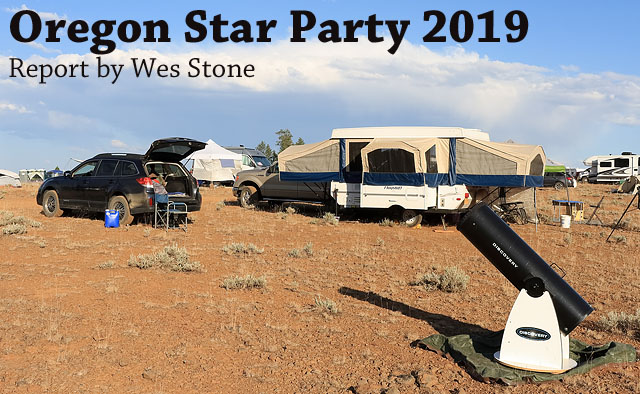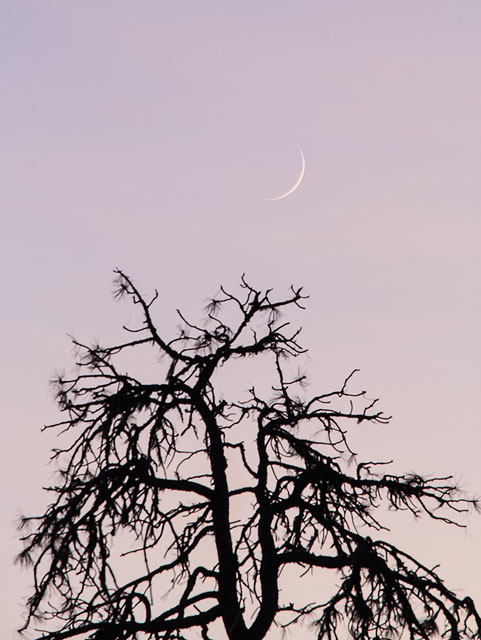It's been a long time since I've done one of these. I've usually been just too busy right after OSP to reflect and write up my experience. This year really isn't an exception, so my report won't be as thorough as some of my previous ones, but here goes.
Wednesday Night/Thursday Morning, July 31/August 1
I said I was taking off from work at 2pm; I got out at 4:30 and then had to make a brief stop at home. It's a 4-hour drive to OSP. So, I ended up in the late arrivals parking. I set my scope up behind my car. There was some high cirrus that mostly cleared up, but skies weren't great. When I looked at Jupiter, seeing was below average. Ganymede was transiting, but was rarely discerned against the north polar region. When the satellite's shadow fell on Jupiter a couple of hours later, it was easily visible but the planet was so low by then that the seeing was awful. I was tired, so I just poked around a few things. I got out my chart and tried to find Comet C/2018 W2 (Africano), but there was no trace of it. Either the comet was much fainter than predicted or I had screwed up the chart. I was to find out later that I had screwed up the chart, but in any case I missed this comet at OSP. Hopefully I'll catch it during the next new moon cycle.
I was tired from my long day, so I decided to take a nap and get up at 2:00 or so. I ended up sleeping well past that. Morning twilight comes really early in late July! I did manage to pick up another comet, C/2018 N2 (ASASSN) in Aries. The comet was small and faint with a strong central condensation. I didn't see a stellar nucleus. The outer coma was difficult to discern, but may have been elongated slightly to the west. Otherwise, the comet was round. Sketch.
Thursday Night/Friday Morning, August 1/2
I moved to the main camping area and found a spot to the west of the 802 road beyond the loop. During the afternoon, some clouds built into thunderheads and dripped a very few drops of rain. Not enough to settle the dust. There was a rainbow in the east and at least one distant lightning strike. After sunset, the seeing was better than the night before, although still only average. On Jupiter, there was nice detail and the Great Red Spot was prominent. I made a sketch. In addition, Europa emerged from eclipse during twilight, always a really interesting event to watch.
I can't say I was extremely motivated to observe. I poked around the showpieces of the summer sky and also sketched a couple of galaxies in Draco including NGC 6643. This galaxy was a fairly large oval galaxy with a round core and small central condensation, and a couple of bright patches in the halo along the major axis.
I was planning to do a meteor count starting at 1am, but low rates and fatigue made me stop quickly. I took another nap and again overslept and woke up fighting twilight. I picked up my second and last comet of OSP 2019, 260P/McNaught. Like C/2018 N2, this comet wasn't much to look at and the reward was in just detecting it. My notes read: "Very small. Difficult at first, but a round haze eventually held with direct vision. Stellar pseudonucleus surrounded by a tight inner coma. With averted vision, appears elongated NE-SW, at times strongly. Fortunately, the comet did have some interesting company on this night. The much brighter galaxy NGC 520 (actually an interacting galaxy pair) was in the same field of view. My notes for NGC 520: "Dominates the mid-power field. Strongly elongated E-W. Stellar core in W portion; another condensation in E portion. Strongly mottled with high surface brightness along major axis. Faint outer halo extending to sides on W end. E end narrows to a point." Sketch.
Friday Night/Saturday Morning, August 2/3
Tonight featured even better seeing than the night before. I did another sketch of Jupiter during twilight, and got to see the detail on the other side of the planet. Other than that I didn't have a really productive night. I always think I should make the rounds and visit other astronomers and look through their scopes, but I really don't do it very often. On this night I did go over to Eddie Allen's 24" f/2.75 "Elvira" scope. The scope is phenomenally engineered, but the real reason I wanted to look was because of the night vision system he was using. After looking at a number of different nebulae, I was pretty impressed although I wonder how well it would perform in a smaller, slower scope.
Saturday morning featured a rare occurence of dew at OSP. I picked up the two comets again but didn't do much else.
Saturday Night/Sunday Morning, August 3/4
This was the best night of the star party. I came up with a list of objects to observe and ran through many of them. Dave Powell's talk featured another pass of the ISS and was capped off by a Perseid fireball. Then I got down to observing. Before it got dark, Jupiter looked nice with Io's shadow and the Great Red Spot on the disc. I didn't sketch it tonight, but I did sketch some other objects:
Terzan 7: Faint globular cluster. Hard to pick out at first. Followed Sue French’s directions; much as she said, a very faint round haze at the southern end of an oval of stars. Looked like eastern and southern edges had mottling—possibly star clumps at the edge of resolution. Difficult direct vision object.
NGC 5529: "Flat Galaxy" in Bootes. Needle-like appearance. Low surface brightness overall; a bit brighter in the center with a distinct central condensation. Somewhat brighter along the center of the major axis. Pretty intense diffuse mottling.
NGC 4605: Large, high surface brightness galaxy. Very much elongated. Not much of a central bulge; core area is brighter but no distinct nucleus. Looks barred. Elongated NW-SE. Extremely mottled with knots all along the major axis.
NGC 5308: Very high surface brightness, thin, elongated galaxy. Visible as a small, bright streak at low power. At 330x, has a bright core, stellar nucleus offset just S of center. Extensions NE and NW of the nucleus. One prominent knot in the E end of the galaxy; other than that the E end appears fainter while the W end appears brighter and smoother.
NGC 5389: Small, oval galaxy with a small core and flocculent outer halo. Elongated ~N-S. NGC 5379 in same field is much fainter (AV1). Oval, very faint stellar nucleus, elongated SW-NE.
NGC 40: The classic planetary nebula in Cepheus, with a bright central star. A broken bright outer ring with several condensations on the west side and a linear feature on the east side. A somewhat fainter inner ring with patchy variations in brightness and a brighter spot just SE of the central star.
NGC 1501: Planetary nebula in Camelopardalis. Visible at low power as a small but distinctly nonstellar oval with a hint of annularity. At 330x, fairly low surface brightness. Central star easily visible but dim. Annular with structure. Elongated very slightly N-S. On N side, annular nature seems to be caused by a void between the outer and inner shell. On the S side, void is broken by brighter areas.
My best limiting magnitude count yielded 7.0; certainly not one of the best nights ever at OSP but well above average for the past several years. Skies were never exactly smoke-free during this year's star party, but sometimes I could get some views reasonably close to the horizon.
I called it a morning a bit earlier on Sunday, with the long drive ahead of me and work the next day. Another successful OSP in the books.


